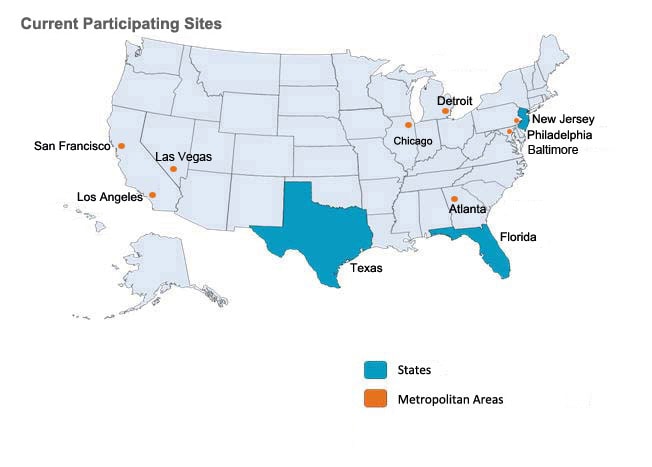Purpose
National ALS Registry describes the outcome of the State-Metro ALS Surveillance project. Read more about the background, methods, and primary results of the study evaluating selected states and metropolitan areas.

Summary
ATSDR funded state and metropolitan area-based surveillance projects to support the National ALS Registry.
Selected state and metropolitan area ALS surveillance projects were conducted to:
- Assist ATSDR in evaluating the completeness of the National ALS Registry.
- Obtain reliable and timely information on the incidence and prevalence of ALS.
- Better describe the age, sex, race and other characteristics of persons with ALS (persons living with ALS).

Methods
State and metropolitan areas project staff contacted neurologists to report persons with ALS.
State and metropolitan areas were selected to over-represent minority populations because of concerns that these groups might be missing from the National ALS Registry.
- Participating States: Florida, New Jersey and Texas.
- Participating Metropolitan Areas: Atlanta, Chicago, Baltimore, Detroit, Las Vegas, Los Angeles, Philadelphia and San Francisco.
Recruitment of Neurologists
To identify neurologists who diagnose or provide care for persons living with ALS:
- Lists of neurologists were obtained from outside vendors, state licensing boards, and other resources.
- Neurologists specializing in pediatric neurology or neurosurgery in urban areas and those no longer practicing in the area (e.g., moved or deceased) were removed from the lists.
- Letters were sent and phone calls were made to the neurologists to determine if they diagnosed or treated persons living with ALS during the three year project period.
Every neurologist who diagnosed and/or provided care to a person with ALS from January 1, 2009 – December 31, 2011 was asked to report his case(s).
Data Collection
- The neurologist completed a brief Case Report Form, which included information on demographics, date of diagnosis, and El Escorial Criteria classification, for each person with ALS.
- A more detailed Medical Records Verification Form was completed on up to 20% of the cases and submitted with an electromyogram (EMG) to the consulting neurologist for verification of diagnosis.
- Death data were evaluated to identify possible cases of ALS not reported to the surveillance project. When physicians could be identified on death certificates, they were contacted to determine why the person was not reported and attempts were made to collect case reports for eligible decedents.
Results
The demographic characteristics of those with ALS are similar to the published literature, i.e., persons with ALS are more likely to be male, white, non-Hispanic, and older. Incidence rates were calculated when data were sufficient and they are also mostly consistent with the published literature. A project summary for each participating State and metropolitan area can be reviewed at the following links:
